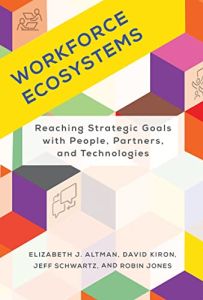Acesse a sua conta getAbstract para obter o resumo!

Acesse a sua conta getAbstract para obter o resumo!
Jeff Schwartz, Elizabeth J. Altman, David Kiron and Robin Jones
Workforce Ecosystems
Reaching Strategic Goals with People, Partners, and Technologies
MIT Press, 2023
Sobre o que é?
The structure of organizations is radically shifting – learn why conceptualizing workforces as flexible, dynamic ecosystems will help you create more value and better job experiences.
Recommendation
The emerging workplace looks very different from the rigid, hierarchical workplace of the past, say writers Elizabeth J. Altman, David Kiron, Jeff Schwartz and Robin Jones. Today’s workforces have more of an ecosystem structure than the traditional silo structure. If you want to lead your workforce to success, you need to know how to orchestrate this structure, while respecting the autonomy of all participants. Learn how embracing a more expansive view of your workforce can help your organization reach its strategic goals. Shift your business mind-set, seeing opportunities for collaboration and growth when others see only the threat of competition.
Summary
About the Authors
Jeff Schwartz is the author of Work Disrupted, as well as an adviser on the future of work for Deloitte Consulting, and the vice president of insights and impact at Gloat. Elizabeth J. Altman is an associate professor of management at the University of Massachusetts Lowell’s Manning School of Business. She’s also a guest editor of the MIT Sloan Management Review Future of the Workforce project. David Kiron is the editorial director of research at MIT Sloan Management Review. He’s also a program lead with MIT’s Big Ideas research initiatives. Robin Jones leads workplace transformation at Deloitte, and she serves on the CEO’s Marketplace Leadership Team with Deloitte Consulting.































Comment on this summary